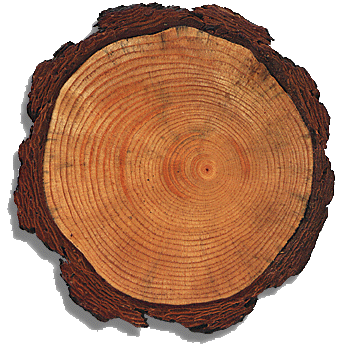
HOW OLD IS THAT TREE?
by Grandpa Cliff Oct 20, 2005

A tree grows best during warm, wet weather. Each year a ring of wood is added to the sapwood in the trunk of a tree and to every branch. When the weather gets cold in late Autumn and Winter, in the Northern States, the tree stops growing. It begins to grow again the following Spring when the weather begins to get warm again.
By counting the number of rings of wood (called Annual Rings) in a trunk or in a branch, you can tell how many years that part has been growing. You then know the age of that part of the tree. The age of the lower trunk would be the same as the age of the whole tree.
Some tree rings are wide and some are narrow. Wide rings form during a year when the weather was very good for growth, such as warm and wet. Narrow rings form during drier years and cooler years.
Notice that the bark in the photos above and below have layers.
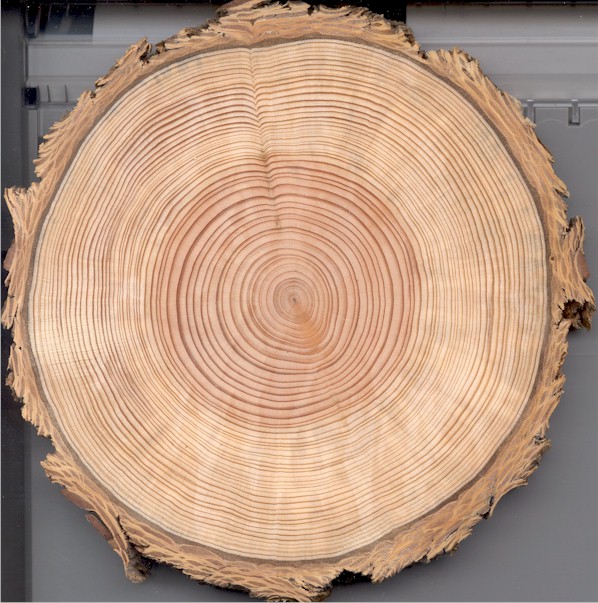
Count the Annual Rings
How old is the tree in the photo? You
can tell by counting the dark lines. The
dark spot in the center is the Pith. The
first dark line outside the pith is the edge
of the first year of growth. Each year of
growth consists two bands; a light band
followed by a dark band. The light band
is the Spring Wood made of large cells
which grew when the weather was wet.
The dark band is the Summer Wood made
of small cells formed when there was less
rain. The two bands look different
because the small cells of Summer absorb
more light and therefore look darker.
See the next photo which shows that the
dark bands have much smaller cells.
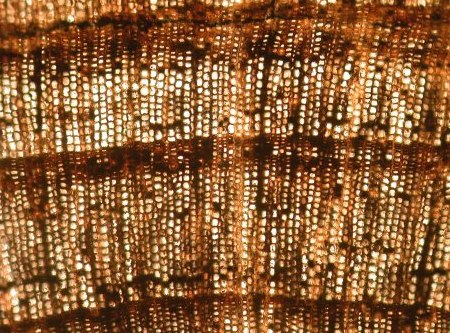
Cambium
Where the bark and wood meet, there is a layer of cells called the Cambium (really the Vascular Cambium). It can be seen in the next photo. Look just below the 24. On the left side of the wood is a dark line. Just to the left of that you can see a lighter line if you look closely. Between these two lines is the Cambium, which makes the new annual ring of sapwood each year.
The Cambium also makes the inner part of the bark. The only part of the bark that it doesn't make is the outside layer (cork) and the cork cambium whose job it is to make the cork. You can see bark layers in the top two photos above. In those types of trees, the bark splits as it gets thicker. Some kinds of trees have smooth, thin bark with hardly any layers in it. Other kinds of trees have a thick bark.
----------------------------------------------------------------------------------
The wood of this tree trunk shown below has 24 annual rings and a knot. There is no darker wood in the middle, so there may not be any heartwood. The outside, darker layer on the left side of the photo is the bark of the trunk. The knot was made from a branch that was overgrown by the sapwood as the tree trunk widened. The knot shows 5 years of growth. The dark area on the right of the knot is bark which is either from that branch or from the trunk itself. The pith can be seen in both the wood (dark) and in the knot (light).
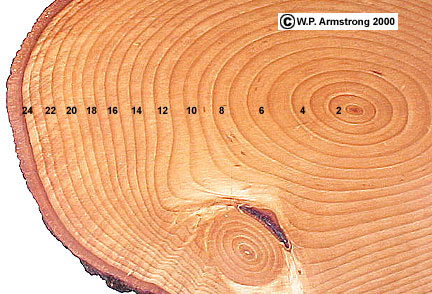
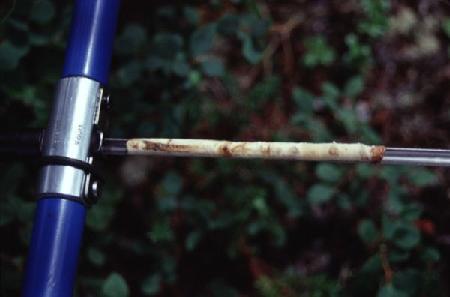
Here is a photo of a borer, which is T shaped. The blue handle is turned many times as the hollow tube screws into the wood of the tree. It cuts out a thin peg of wood, the core, which is then removed from the tree. The core of wood can be seen in the photo. It has been removed from the borer and set on top of hollow tube. Because the annual rings can be counted in the core, it saves the tree from being cut down or the branch from being cut off. However, sometimes boring into wood can injure the tree, so if it is an important tree to science or history (because of its age or for some other reason), removing a core is avoided if at all possible.
----------------------------------------------------------------------------------
Visitors since 30
Dec 2006
Go to the HOME page